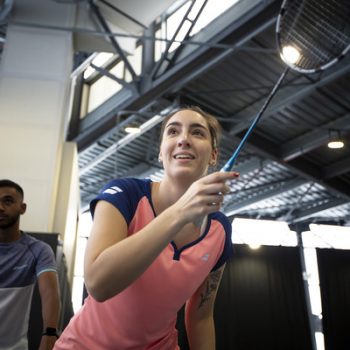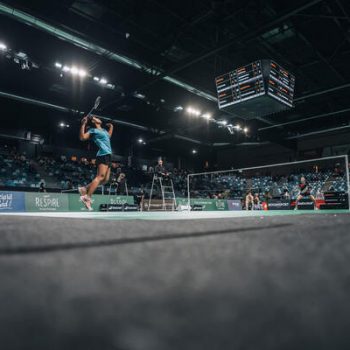Cầu lông: Luôn là niềm vui mà không có chấn thương?
All badminton players have been injured at some point, either during a match or a training session. Whether you’re a singles, doubles or mixed player, there are some “typical” badminton injuries you need to bear in mind. Matt Ashman, the former physiotherapist of the English national badminton team, guides us through the potential injuries and helps us:
● Find out which injuries you’re more likely to get
● Understand why they happen to better avoid them
● Learn how to play safely
Everyone knows at least one badminton player who has injured him or herself during a game. A bad fall, a strained muscle, or an awkward move are all preventable but possible injuries, whatever your playing level. For an insider’s guide to injury avoidance, let’s hear from Matt…
1. Which sort of injuries are badminton players prone to?

As you know, each sport, by its very nature, calls on different muscle groups and bases. But some injuries are more common in badminton than others, whether you’re a singles or a doubles player.
As players need to hit the shuttle repeatedly, which stretches the tendons, the shoulders are among the most frequently affected body parts – but far from the only ones. “Due to the nature of the sport and repeated stretching, lower body, back and lumbar spine injuries are the most common,” says Matt. On-court jumping, moving, and start/stop running also weakens “the ankles, raising the risk of sprains or injuries to the Achilles tendon,” he adds.
Tendinopathies are more common among singles players. “The knee tendon has to work harder because the player needs to cover a much greater distance on court and decelerate fast, which can damage the patellar tendon,” explains Matt.
We also find that female players run a greater risk of anterior cruciate ligament rupture, partly because of the anatomy of the knee joint in women. Located in the centre of the knee, it comes under a lot of pressure when you land after a jump.
2. Understanding why injuries happen to better avoid them

Injuries can have many causes. Below, Matt shares his top tips on reducing the risk of injury and lowering your chances getting hurt.
– Poor physical condition: contrary to appearances, badminton is a demanding sport. If you play badminton for pleasure, it’s easier to injury yourself since your body may not be prepared to take the extra strain. Don’t forget to warm up and, above all, learn the right moves.
– A break from badminton: players are more likely to suffer an injury after a holiday, illness, or an extended break from the game. Bear in mind that regular exercise keeps you in good physical condition. When you return from a break, your body is less prepared than usual, which is something to remember when you get back on court.
– Poor recovery: let your body recover from one bout of exercise before you begin another. “Fatigue increases the risk of damage to muscle tissue, but also to ligaments, and can cause sprains and tendon problems since it reduces muscle activity and decreases proprioception,” explains Matt. The trick is to stretch between games or exercises so your body can recover properly.
– “Accumulated load”: or put another way, “too much sport”. It is very important to balance your recovery load after your workout since, according to Matt, you need to “prepare your body, yes, but don’t wear it out in advance.” If you feel the urge to exercise, opt for other, gentler activities, such as swimming or cycling.
This list is far from complete and there are plenty of other ways to avoid injury, including by paying attention to your diet, and avoiding fatigue or stressful situations. The more factors you accumulate, the greater the likelihood of injury. But remember: if you are mentally and physically relaxed and prepared for the effort, you’re unlikely to get injured.
3. Learn how to play safely
Don’t worry! You’re not doomed to suffer injuries while playing badminton. If you prepare your body in advance, you’re much less likely to get hurt. For Matt, this means “staying fit and training regularly to build up your strength, muscular endurance, and power to prepare your major muscle groups.”
To minimize the risk of injury, you should therefore focus on your:
– Temperature: increase your muscle temperature before exercise. “Body or room temperature is one thing but muscle temperature is quite another,” says Matt The best way to remember all your muscle groups is to warm them up one group at a time. Next, do faster and more powerful shuttle movements, and practice shadow play by moving around the court as you go through the motions.
– Stretching: stretch at the end of your session or match, by practicing slow, gradual movements. Speed up your recovery by wearing compression garments or give yourself a massage – or better still, get someone else to do it!
– Diet: give your body the right amount of “fuel” before and after a session. How many calories you consume depends on the intensity of the physical activity. “You need to eat enough carbohydrates and protein not only to burn them off during training but also to start your recovery.”
– Training: maintain a regular training schedule. Even on holiday, 10 minutes and a few simple exercises are all it takes to keep your body in shape: “Do some shadow play with your racket and lunge exercises for the lower limbs,” advises Matt. The idea is to do a few exercises on a regular basis – it’s what Matt calls “maintaining a minimum dosage.”
– Sleep: get into a sleep routine to prepare your body before bedtime. “Hot baths, meditation, and sleeping in a completely dark place at room temperature will all help you relax,” says Matt. The good thing about this routine is that, even if you’re not training or competing, you can still get a good night’s sleep.
– Equipment: buy quality equipment, especially shoes. Do your shoes have the right cushioning system? Is your foot well supported? We recommend shoes specially designed for badminton players to give your feet good lateral protection during rapid direction changes.
Professional badminton players generally tend to be injured more often than leisure players. But all players run risks on court, especially if they are not physically and mentally prepared for the game. “The more you prepare and rest your body, the more able it will be to rise to the challenges of the game, reducing the likelihood of injuries caused by fatigue and intense movements,” concludes Matt. A few simple rules such as a healthy lifestyle, a balanced diet, and enough sleep, coupled with regular training adapted to your sessions will prepare your body and hone your performance. So, if you want to avoid injuries, take a broad-based approach… and follow all the recommendations above!
Bài viết này hữu ích với bạn?







